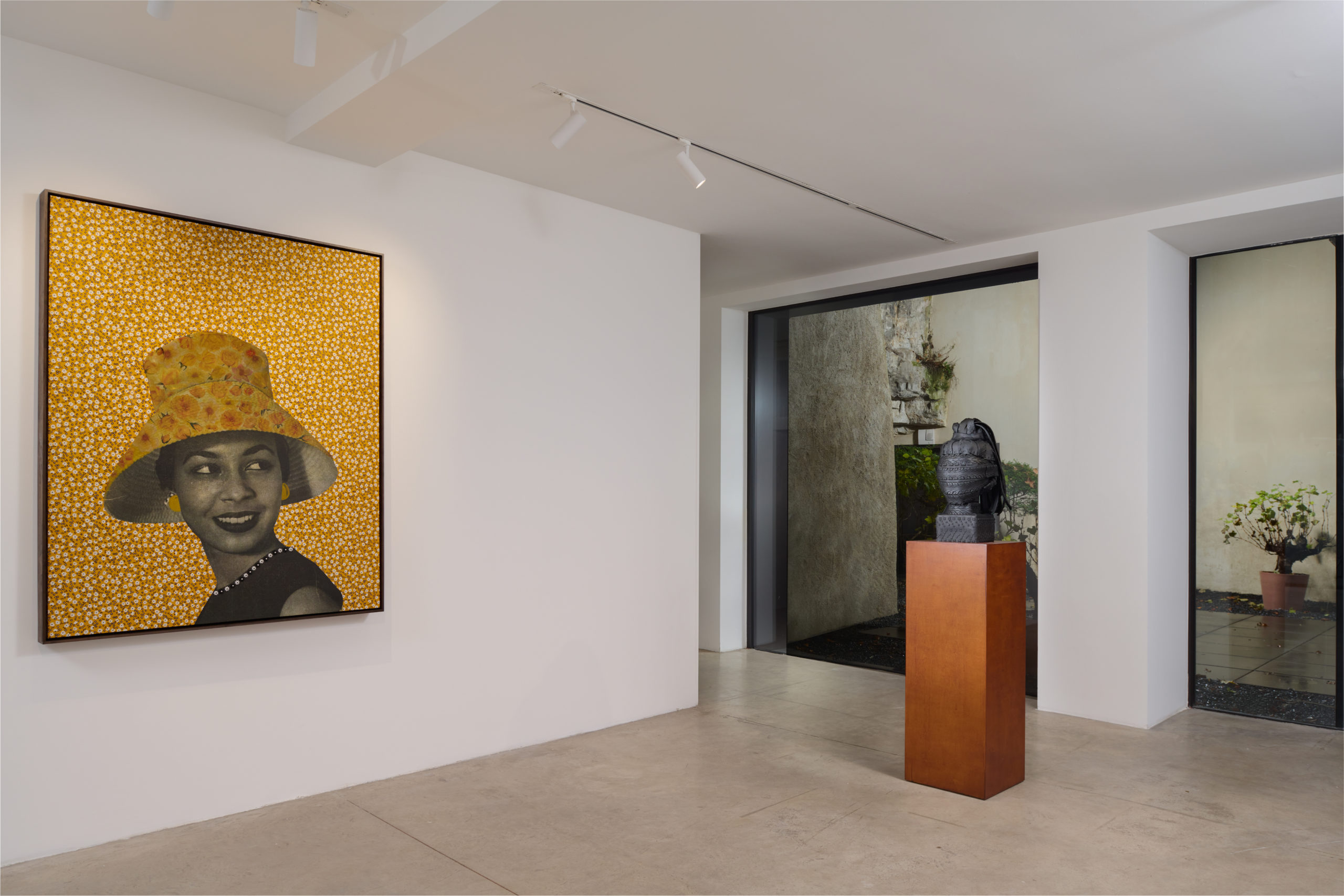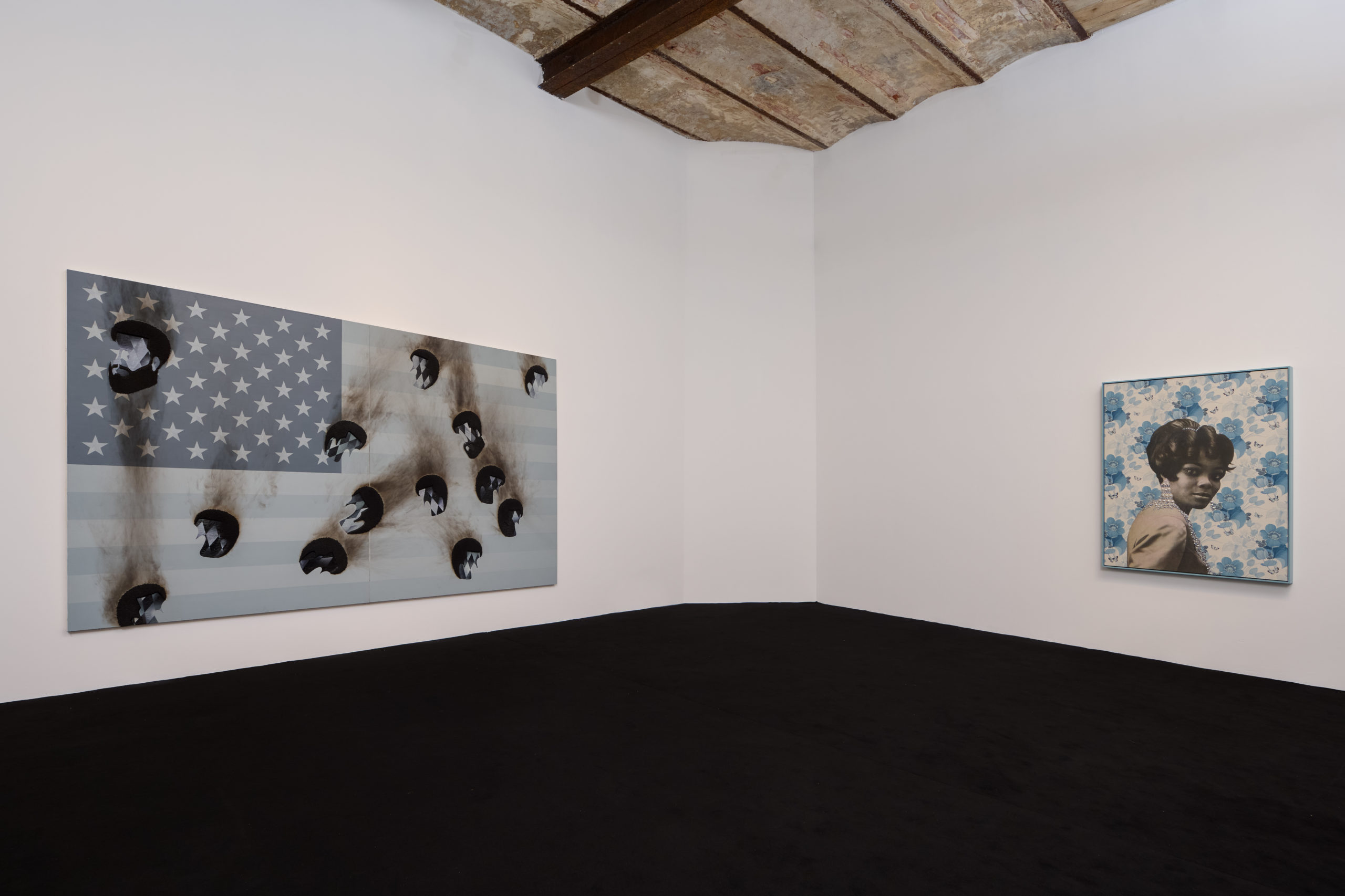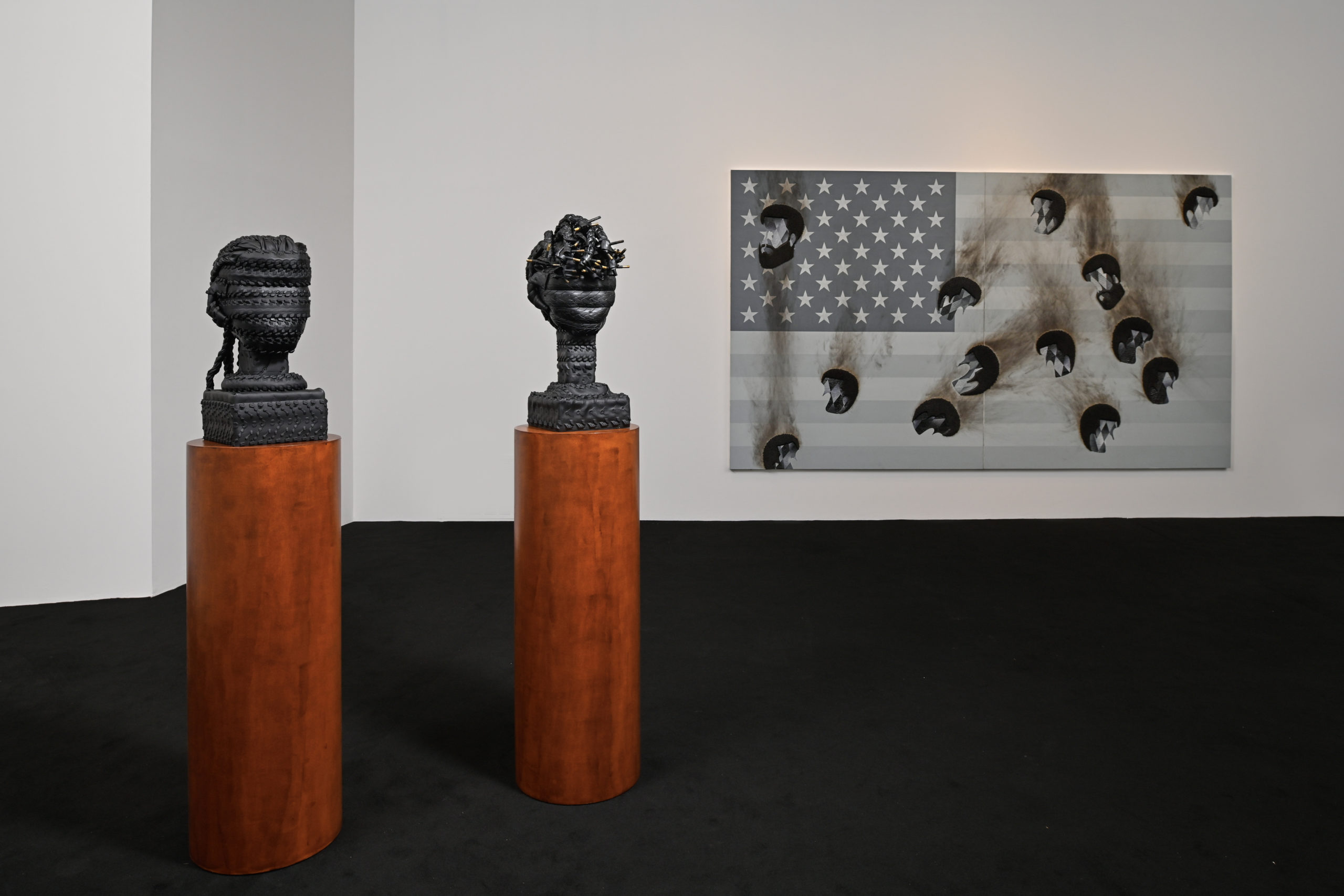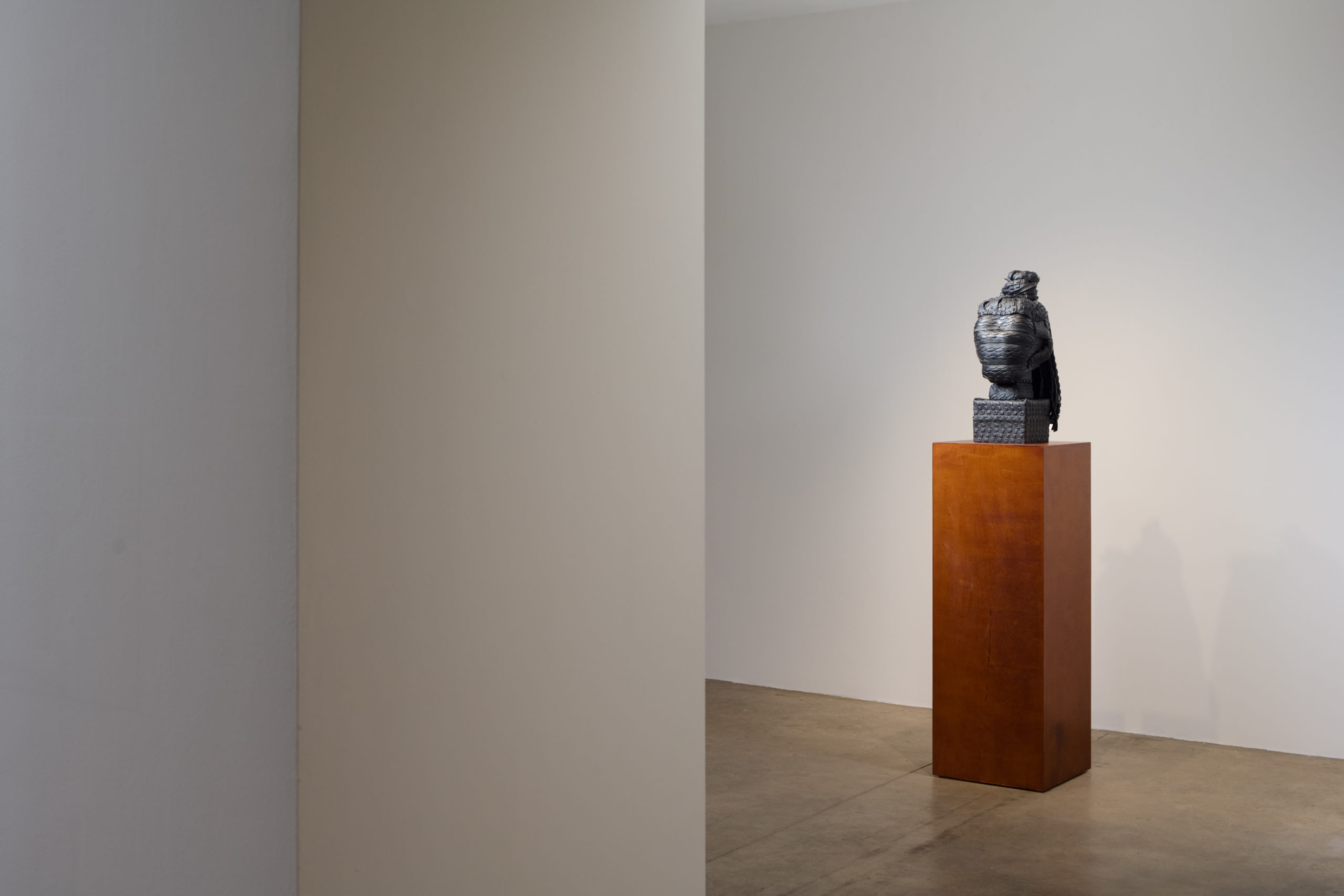
Zidoun-Bossuyt is pleased to announce “Dueling Consciousness” a three-person exhibition of works by Kim Dacres, Genevieve Gaignard, and Jeff Sonhouse.
PRESS RELEASE
Zidoun-Bossuyt is pleased to announce “Dueling Consciousness” a three-person exhibition of works by Kim Dacres, Genevieve Gaignard, and Jeff Sonhouse. Collectively these works accentuate the difficult reality of being Black alongside another identity marker. The title draws on W.E.B Du Bois assertion of “Double Consciousness” or “looking at one’s self through the eyes of others”, which is further articulated by Ibram X. Kendi as a person existing on a spectrum of assimilation, segregation, and anti-racism.
In his work, Untitled (Flag), Jeff Sonhouse explicitly addresses the violence of assimilation in order to be Black in America. He uses the American flag as a background symbol of bombardment and exploding facelessness rendered in black, white, and gray, yet ablaze. Sonhouse’s distinctive painting vocabulary includes the use of matches collaged painstakingly one-by-one and then burnt, the canvas capturing ash from the rising smoke.Jeff’s focus on a faceless or disembodied head represents the impact of one’s mental state within a double or dueling consciousness, while maintaining the universality of what it may feel like to assimilate into a resisting space.
Gaignard’s large scale collage works, Golden Brown (2022) and When Sunny Gets Blue (2022), uses vintage materials and found imagery to highlight how racial acceptance or proximity to whiteness are still expectations made of Black people today. Where violence may not be an option towards acceptance, Black women must use a knowing glance to hold space and simultaneously advise others. Gaignard’s work recognizes the precariousness of living in between predominant notions of beauty and Black womanhood while speaking to the deft and defiant ways Black women must move through space in order to protect and maintain a sense of self. Gaignard states, “even when Black people are forced to move towards acceptance, towards the comfort levels of others, the style still has to have its own spin on it.”
Dacres’ busts –Des (2023), Marian (2023), Lorna (2023), and Linda (2023) show the constraints of hairstyles and broader societal acceptance of Black women in space. Dacres shares’, “the mothers of my friends from school were all Black women and they knew that their daughters were entering predominantly white educational and work spaces, where they would feel at war with themselves. Amongst the mothers, there was community in acknowledgment through shared glances and looks.” Dacres’ uses the naming to honor these women and to address how braids and styling impact how Black women and girls are viewed in the spaces they hold. Placing the tire wrapped busts on stained wood plinths highlight the notions of natural versus unnatural styling imposed on Black women, Black people, and people of color at large.
The works in Dueling Consciousness present us with interpretations through painting, collage, and sculpture of what it feels like when Black people in America or elsewhere are forced to live in between or within performative expectations. Uniting all of the works is the gaze: the focus on the presence of a gaze in Gaignard’s work, the absence of a gaze in Dacres and Sonhouse work, and the impact of an exterior gaze in Sonhouse’s work of an exterior gaze on one’s sense of place.
Kim Dacres
Kim Dacres is a visual artist using found tires and rubber to create sculptures celebrating influential forces in her life such as family, community, musicians, athletes, and ideas. Dacres’ process involves collecting and disassembling tires, layering them around wooden armatures using screws, and treating them with spray paint. In her work, Dacres emphasizes the facial expressions and hair styles of each piece in order to capture some of their charisma and celebrate their Blackness while also considering who is entitled to space and deserving of honorifics and monuments.
She is attracted to discarded rubber because of the color, smell, and the material’s symbolism imbued with a wealth of experience paired with wear, tear, and sudden disregard. Through the process of layering the materials, the rubber’s journeying experience transforms into muscle, bone, skin, hair, and personal style. Her work considers the texture of experiences unique to Black People and women and the fragments of their experiences that shape a world view.
Dacres was born in the Bronx to Jamaican immigrants. She has her MS from CUNY Lehman College in Teaching English to Speakers of Other Languages (2010) and her BA from Williams College in Political Science, Art Studio, and Africana Studies (2008.) Dacres’ work has been exhibited around the world, including recent solo exhibitions at Charles Moffett Gallery in New York City (2023), Gavlak Gallery in Palm Beach, FL (2021) and Los Angeles (2020), as well as group exhibitions internationally and within the U.S., including Black American Portraits at Spelman College Museum of Fine Art, Atlanta, GA (2023) and Los Angeles County Museum of Art, Los Angeles, CA (2021), Sounds of Blackness at The Metropolitan Museum of Manila, Philippines (2023), The Beth DeWoody Collection at The Bunker in Palm Beach, FL (2022), Godhead – Idols in Times of Crisis at Lustwarande 12th Edition, Tilburg, Netherlands (2022), Arrangements in Black at Phillips, New York, NY (2022), From a Place, Of a Place, presented by ArtNoir X regularnormal X Meatpacking District, New York, NY (2021), Through the Looking Glass, presented by UTA Artist Space, Beverly Hills, CA (2021). Dacres is the recipient of the Artadia New York Award Grant (2022). Her work is included in museum collections at the Los Angeles County Museum of Art (LACMA), the Institute of Contemporary Art Miami, the South Carolina International African American Museum, and the Nasher Museum at Duke University. Kim Dacres lives and works between Harlem and the Bronx, New York.
Genevieve Gaignard
As an interdisciplinary artist I investigate personal histories, popular culture and racial currents through my lens as a biracial woman navigating unsettling American realities.
I insert myself into the work by mining my experiences, implementing soft color palettes, humor and domesticity. My goal is to create environments and experiences that awaken critical thinking and offer a shift in perspective. Activating spaces with haunting nostalgia for America’s past-as-present, I beckon viewers to dig into the imperfect relationship between our inner worlds, public lives, and modern events.
Each of the mediums I work with is a conduit for introspection. My photographs are staged self-portraits presenting a spectrum of invented yet recognizable “selves,” which undermine social hierarchies and beauty standards. Vintage wallpaper is a motif throughout my collage, sculpture, and installation work. This material, a childhood sentiment, serves as an accent or backdrop to the found objects and images I use to assemble my work. In collages, I embrace xerography, a meditation of sifting through historical news media, magazines, and portraiture. Through sculpture and installation, I showcase antique furniture, decor and figurines reimagined into unexplored psychological spaces. Installation is my channel to create imagined domestic environments as sites of sanctuary and resistance. In doing so, I expand on the vernacular of found objects and settings found in my photography and collages. Sculpture allows me to reanimate the personifications of society’s deference to Whiteness into symbols of objection. The scope of my work is an ensemble of visual renderings that affirms Black livelihood and provokes reflection on the often-hostile realities of the outside world.
Genevieve Gaignard is a multidisciplinary artist that splits her time between her hometown in Massachusetts and Los Angeles. Her work elicits dialogue around class, race and cultural identity. Last year she presented two solo exhibitions: To Whom it May Concern with Rowan University Art Gallery and Strange Fruit with Vielmetter Los Angeles. Her work has appeared in numerous group exhibitions, including The Nerman Museum, Overland Park, KS; Rennie Museum, Vancouver, CA; The Broad, Los Angeles, CA; The Los Angeles County Museum of Art, Los Angeles, CA; The San Jose Museum of Art, San Jose, CA; The Blanton Museum of Art, Austin, TX; The Getty Center, Los Angeles, CA; The National Portrait Gallery, Washington, D.C.; Crystal Bridges Museum of Art, Bentonville, AR; The Studio Museum, Harlem, NY. In July 2022, Gaignard partnered with Orange Barrel Media on Look At Them Look At Us: a permanent, site-specific public art installation in downtown Atlanta. Gaignard received her BFA from Massachusetts College of Art and Design and her MFA from Yale University.
Jeff Sonhouse
Over the past ten years, the American artist Jeff Sonhouse has created a powerful body of portrait paintings depicting often-masked black male figures that consistently defy and obscure classification. Sonhouse uses masking to reveal as well as to conceal issues of identity in our culture. The matches, smoke and burned areas seem to hint at the incendiary nature of race relations in America. Sonhouse’s paintings include references as varied as traditional African masks, art historical figures as Romare Bearden, Charles White or Pablo Picasso.
Sonhouse’s subject is the African American male within Western culture, employing a visual language he has developed over the years. Repeated and edited over time, these characters have become his own. Sonhouse’s figures are presented frontally, painted close up to appear right on the canvas surface and indeed, are frequently built up with collage elements to extend into the viewer’s space. The paintings are both beautiful and provocative.
Sonhouse’s distinctive painting vocabulary includes the use of cut and collaged magazine images, carefully patterned and collaged matchsticks, steel wool and soldered metal, set against his carefully rendered painted illusions. His trademark harlequin pattern, superimposed upon the faces of his subjects, immediately makes the viewer aware that, although realistically painted, these are symbolic images. By drawing upon specific and overtly violent and sexual imagery prevalent in our culture, and by pushing his figures’ symbolism to the extreme, Sonhouse exposes the hypocrisy and absurdity inherent within the myths that surround the African American male.
Jeff Sonhouse received his BFA from the School of Visual Arts, New York in 1998 and his MFA from Hunter College, New York in 2001. He won the Joan Mitchell Foundation awards and the New York Foundation for the Art prize both in 2004. His work has been included in exhibitions such as Frequency and The Bearden Project, at The Studio Museum in Harlem in 2005 and 2012 respectively; 30 Americans, at the Rubell Family Collection, Miami in 2009 which traveled widely throughout museums across America through 2016; and Face to Face: Los Angeles Collects Portraiture, at the California African American Museum, Los Angeles in 2017. Solo museum exhibitions include Probable Cause at the Atlanta Contemporary Art Center in 2003, and Opener 26 Jeff Sonhouse: Slow Motion at the Frances Young Tang Teaching Museum and Art Gallery at Skidmore College, Saratoga Springs in 2014. His work is part of public collections including Nasher Museum of Art at Duke University, Durham, NC; Artist Pension Trust, New York; Rubell Family Collection, Miami; and The Pizzuti Collection, Columbus, OH ; The Nelson-Atkins Museum of Art, Kansas City, MI ; Pérez Art Museum Miami, Miami, FL ; Kalamazoo Institute of Arts, Kalamazoo, MI. Jeff Sonhouse’s last solo exhibition was at Zidoun-Bossuyt Gallery in Luxembourg in September 2021. He is a recipient of the 2022 Colene Brown Art Prize.





 UP
UP